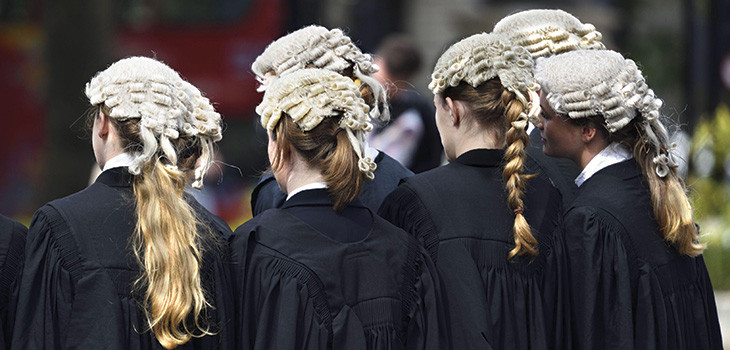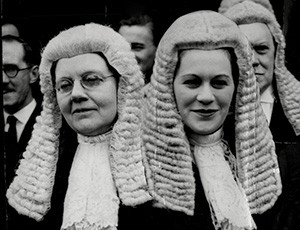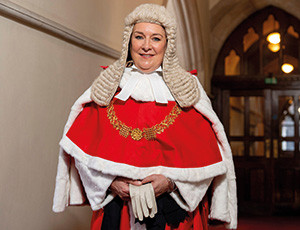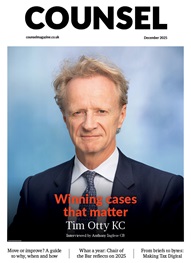*/

At one set, female silks outnumber male silks by 4:1 – and in a male-dominated field of law… Francesca Whitelaw KC shares the secrets to that level of progress with a view to helping equality, diversity and inclusion more broadly
When I started pupillage at the chambers in which I have spent my whole career, the only silks were men and there were fewer women barristers than men. Now, with female silks outnumbering men at 4:1 in Chambers and female to male juniors at a current ratio of 2:3 in a field of law (public law) that remains male dominated, I am increasingly asked, ‘What are the secrets to that level of progress in terms of the recruitment, retention and advancement of women?’
It would be right to recognise that the progress I have seen has not been entirely linear, nor without its difficulties and casualties. In common with many other colleagues, I have seen brilliant women leave the Bar, due in no small part to the seemingly impossible prospect of combining this career with family commitments. But I see it less now, particularly within my chambers, and the Bar is almost unrecognisable to me from 20 years ago. It is a much better place. Progress may be slow but it is important to reflect on our achievements in order to inspire even greater positive change.
This article focuses on my own experience of the progress of women at the Bar, with the hope that what we have learned in terms of the barriers to, but benefits of, equality for women, will help diversity and inclusion far more broadly. It is also only relatively recently that gender has been recognised in society to encompass more than the binary male-female divide and that recognition has yet to be fully reflected in the law, at the Bar and within the Judiciary.
These are some of the principal factors that I believe make a difference:
First and foremost, I am very fortunate to have spent my career at a supportive and friendly set of chambers where men and women encourage each other. In particular, relatively early on I found myself based in a wing with five other women (quickly earning the unofficial and inappropriate nickname, ‘the Coven’). As Baroness Hale of Richmond has previously articulated, the experiences of women’s lives are often different from the experiences of men’s lives, and to be surrounded by other women at work – younger and older, from different backgrounds, at similar and different stages of life – has been immeasurably encouraging at challenging times. It could be a shared understanding of the rumination and self-criticism to which women may be particularly vulnerable after a bad day in court; or empathy for the ‘mental load’ which accompanies family responsibilities; or something lighter – a book, film, theatre, food or fashion recommendation, which represented a shared interest or perspective and provided relief from the stresses of work.
Supportive clerks are vital to all barristers and mine – in particular, my senior clerk with whom I have worked since pupillage – have always sought to understand the particular challenges that women experience at different stages of life at the Bar, and, quite simply, to relieve the pressures and make life easier wherever possible.
Secondly, and at risk of attributing all my career positives to luck in a way that has been identified as being a particularly female trait, I am very fortunate that my pupil supervisors – one female, one male – have supported and encouraged me for two decades. Both taught me everything I needed to know to progress in Chambers’ areas of legal specialisms but both have also been role models for identifying and harnessing individual strengths, for embracing diversity and for prioritising family life alongside busy professional lives.
Over the years, I have found other mentors and role models in leaders and colleagues in Chambers and from other chambers, and in members of the Judiciary. Again, these have been both men and women – it is not only women who are feminists. I have also learned much from my pupils and from mentoring for outreach programmes and I would encourage others to cast the net widely when looking for barristers, future barristers and judges from whom one can learn and be encouraged and inspired. The best mentoring relationships – whether formal or informal and in whatever way such relationships might arise or be labelled – are usually reciprocal.
Thirdly, early on during the COVID pandemic, a female colleague persuaded me, and a handful of junior women in Chambers, to attend an online event run by one of the Inns of Court to encourage women to apply for silk. We attended in a spirit of jest (what ‘upstarts’ we thought must be!) and I doubt any of us would have attended if it had been an in-person event, rather than a seminar where we hid safely out of sight, first names only, cameras off.
But at that event we couldn’t help but be inspired and drawn in by the intelligent and articulate but entirely approachable female silks who demystified not only the process but the role and our perception of the persons to whom that role belongs.
It brought home to me why representation matters. When women see other women succeeding and performing leading roles – whether that be King’s Counsel, heads of chambers, or members of the Judiciary, it inspires confidence and motivation and helps create a more inclusive and welcoming environment. This of course applies not only to the Bar but throughout society in areas where greater diversity of representation is needed.
Fourthly, Chambers has for many years now undertaken analyses of the allocation of work and fees as between men and women to ensure fairness and accountability. Appearances and impressions can be deceptive and never more so than at the self-employed Bar where it may be difficult to assess the reasons for and factors contributing to different levels of income. By way of simple example, is one person receiving higher levels of work or higher fees for reasons which may be discriminatory or are they simply doing more work and doing it well?
Data analysis is one of the fairest ways to try to answer these sorts of questions though it is not perfect and should be combined with a range of equality, diversity and inclusion initiatives – ideally overseen by a committee that is fairly representative of chambers or the more diverse chambers to which a set may aspire.
It is also not always good enough that opportunities are equal: they may need to be equitable and this is not the same. For example, a woman who has just returned from maternity leave (or equally any member of chambers with caring responsibilities) may not be able to travel far or stay away from home overnight for consecutive nights. Taking into account chambers’ areas of work, appropriate policies and good clerking should seek to accommodate such restrictions.
Fifthly, two of the factors that make the biggest difference to family life and to wellbeing, in my view, are certainty and reasonableness in the demands of work. The Bar may be one of the most difficult professions in which this can be achieved but attitudes have improved over the last 20 years and the benefits of efforts to create certain and reasonable deadlines and workloads are increasingly being recognised.
Everyone – leaders, juniors, judges, clerks – has a responsibility to assess and communicate clearly their own capacity and constraints; to provide realistic time estimates; to delegate tasks fairly, efficiently and responsibly; to plan ahead and – importantly – to leave margins. It is easier said than done but it is only through such actions that family life and wellbeing may be properly respected. Countless studies have shown the productivity benefits that will result. It is also the surest way to retain talent.
Finally, there are enough serious problems in the world. Whenever we can respond with humanity and humour we are likely to engage with the widest audiences. Perhaps it is appropriate that this summer saw the highest grossing opening weekend in the US for a film directed by a woman: Barbie.
‘I wanted to make something anarchic and wild and funny and cathartic,’ said Greta Gerwig quoted in the New York Times, and ‘my hope for the movie is that it’s an invitation for everybody to be part of the party and let go of the things that aren’t necessarily serving us as either women or men.’
If there were those who were (not unreasonably) discomforted by Barbie’s World allowing only a few men onto her Supreme Court, I was reminded of Ruth Bader Ginsburg’s reflection:
‘When I’m sometimes asked when will there be enough [women on the Supreme Court] and I say, “When there are nine,” people are shocked. But there’d been nine men, and nobody’s ever raised a question about that.’
Maybe there will be enough when we no longer have the need to count, and the scales of justice are balanced by true ability, integrity and a range of perspectives rather than by gender.



When I started pupillage at the chambers in which I have spent my whole career, the only silks were men and there were fewer women barristers than men. Now, with female silks outnumbering men at 4:1 in Chambers and female to male juniors at a current ratio of 2:3 in a field of law (public law) that remains male dominated, I am increasingly asked, ‘What are the secrets to that level of progress in terms of the recruitment, retention and advancement of women?’
It would be right to recognise that the progress I have seen has not been entirely linear, nor without its difficulties and casualties. In common with many other colleagues, I have seen brilliant women leave the Bar, due in no small part to the seemingly impossible prospect of combining this career with family commitments. But I see it less now, particularly within my chambers, and the Bar is almost unrecognisable to me from 20 years ago. It is a much better place. Progress may be slow but it is important to reflect on our achievements in order to inspire even greater positive change.
This article focuses on my own experience of the progress of women at the Bar, with the hope that what we have learned in terms of the barriers to, but benefits of, equality for women, will help diversity and inclusion far more broadly. It is also only relatively recently that gender has been recognised in society to encompass more than the binary male-female divide and that recognition has yet to be fully reflected in the law, at the Bar and within the Judiciary.
These are some of the principal factors that I believe make a difference:
First and foremost, I am very fortunate to have spent my career at a supportive and friendly set of chambers where men and women encourage each other. In particular, relatively early on I found myself based in a wing with five other women (quickly earning the unofficial and inappropriate nickname, ‘the Coven’). As Baroness Hale of Richmond has previously articulated, the experiences of women’s lives are often different from the experiences of men’s lives, and to be surrounded by other women at work – younger and older, from different backgrounds, at similar and different stages of life – has been immeasurably encouraging at challenging times. It could be a shared understanding of the rumination and self-criticism to which women may be particularly vulnerable after a bad day in court; or empathy for the ‘mental load’ which accompanies family responsibilities; or something lighter – a book, film, theatre, food or fashion recommendation, which represented a shared interest or perspective and provided relief from the stresses of work.
Supportive clerks are vital to all barristers and mine – in particular, my senior clerk with whom I have worked since pupillage – have always sought to understand the particular challenges that women experience at different stages of life at the Bar, and, quite simply, to relieve the pressures and make life easier wherever possible.
Secondly, and at risk of attributing all my career positives to luck in a way that has been identified as being a particularly female trait, I am very fortunate that my pupil supervisors – one female, one male – have supported and encouraged me for two decades. Both taught me everything I needed to know to progress in Chambers’ areas of legal specialisms but both have also been role models for identifying and harnessing individual strengths, for embracing diversity and for prioritising family life alongside busy professional lives.
Over the years, I have found other mentors and role models in leaders and colleagues in Chambers and from other chambers, and in members of the Judiciary. Again, these have been both men and women – it is not only women who are feminists. I have also learned much from my pupils and from mentoring for outreach programmes and I would encourage others to cast the net widely when looking for barristers, future barristers and judges from whom one can learn and be encouraged and inspired. The best mentoring relationships – whether formal or informal and in whatever way such relationships might arise or be labelled – are usually reciprocal.
Thirdly, early on during the COVID pandemic, a female colleague persuaded me, and a handful of junior women in Chambers, to attend an online event run by one of the Inns of Court to encourage women to apply for silk. We attended in a spirit of jest (what ‘upstarts’ we thought must be!) and I doubt any of us would have attended if it had been an in-person event, rather than a seminar where we hid safely out of sight, first names only, cameras off.
But at that event we couldn’t help but be inspired and drawn in by the intelligent and articulate but entirely approachable female silks who demystified not only the process but the role and our perception of the persons to whom that role belongs.
It brought home to me why representation matters. When women see other women succeeding and performing leading roles – whether that be King’s Counsel, heads of chambers, or members of the Judiciary, it inspires confidence and motivation and helps create a more inclusive and welcoming environment. This of course applies not only to the Bar but throughout society in areas where greater diversity of representation is needed.
Fourthly, Chambers has for many years now undertaken analyses of the allocation of work and fees as between men and women to ensure fairness and accountability. Appearances and impressions can be deceptive and never more so than at the self-employed Bar where it may be difficult to assess the reasons for and factors contributing to different levels of income. By way of simple example, is one person receiving higher levels of work or higher fees for reasons which may be discriminatory or are they simply doing more work and doing it well?
Data analysis is one of the fairest ways to try to answer these sorts of questions though it is not perfect and should be combined with a range of equality, diversity and inclusion initiatives – ideally overseen by a committee that is fairly representative of chambers or the more diverse chambers to which a set may aspire.
It is also not always good enough that opportunities are equal: they may need to be equitable and this is not the same. For example, a woman who has just returned from maternity leave (or equally any member of chambers with caring responsibilities) may not be able to travel far or stay away from home overnight for consecutive nights. Taking into account chambers’ areas of work, appropriate policies and good clerking should seek to accommodate such restrictions.
Fifthly, two of the factors that make the biggest difference to family life and to wellbeing, in my view, are certainty and reasonableness in the demands of work. The Bar may be one of the most difficult professions in which this can be achieved but attitudes have improved over the last 20 years and the benefits of efforts to create certain and reasonable deadlines and workloads are increasingly being recognised.
Everyone – leaders, juniors, judges, clerks – has a responsibility to assess and communicate clearly their own capacity and constraints; to provide realistic time estimates; to delegate tasks fairly, efficiently and responsibly; to plan ahead and – importantly – to leave margins. It is easier said than done but it is only through such actions that family life and wellbeing may be properly respected. Countless studies have shown the productivity benefits that will result. It is also the surest way to retain talent.
Finally, there are enough serious problems in the world. Whenever we can respond with humanity and humour we are likely to engage with the widest audiences. Perhaps it is appropriate that this summer saw the highest grossing opening weekend in the US for a film directed by a woman: Barbie.
‘I wanted to make something anarchic and wild and funny and cathartic,’ said Greta Gerwig quoted in the New York Times, and ‘my hope for the movie is that it’s an invitation for everybody to be part of the party and let go of the things that aren’t necessarily serving us as either women or men.’
If there were those who were (not unreasonably) discomforted by Barbie’s World allowing only a few men onto her Supreme Court, I was reminded of Ruth Bader Ginsburg’s reflection:
‘When I’m sometimes asked when will there be enough [women on the Supreme Court] and I say, “When there are nine,” people are shocked. But there’d been nine men, and nobody’s ever raised a question about that.’
Maybe there will be enough when we no longer have the need to count, and the scales of justice are balanced by true ability, integrity and a range of perspectives rather than by gender.


At one set, female silks outnumber male silks by 4:1 – and in a male-dominated field of law… Francesca Whitelaw KC shares the secrets to that level of progress with a view to helping equality, diversity and inclusion more broadly


Chair of the Bar reflects on 2025
AlphaBiolabs has donated £500 to The Christie Charity through its Giving Back initiative, helping to support cancer care, treatment and research across Greater Manchester, Cheshire and further afield
Q&A with criminal barrister Nick Murphy, who moved to New Park Court Chambers on the North Eastern Circuit in search of a better work-life balance
Revolt Cycling in Holborn, London’s first sustainable fitness studio, invites barristers to join the revolution – turning pedal power into clean energy
Rachel Davenport, Co-founder and Director at AlphaBiolabs, reflects on how the company’s Giving Back ethos continues to make a difference to communities across the UK
By Marie Law, Director of Toxicology at AlphaBiolabs
Are you ready for the new way to do tax returns? David Southern KC explains the biggest change since HMRC launched self-assessment more than 30 years ago... and its impact on the Bar
Professor Dominic Regan and Seán Jones KC present their best buys for this holiday season
Marking one year since a Bar disciplinary tribunal dismissed all charges against her, Dr Charlotte Proudman discusses the experience, her formative years and next steps. Interview by Anthony Inglese CB
Little has changed since Burns v Burns . Cohabiting couples deserve better than to be left on the blasted heath with the existing witch’s brew for another four decades, argues Christopher Stirling
Pointillism, radical politics and social conscience. Review by Stephen Cragg KC